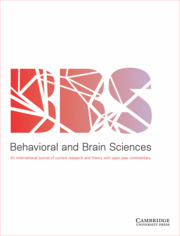Crossref Citations
This article has been cited by the following publications. This list is generated based on data provided by Crossref.
Braem, Senne
Chai, Mengqiao
Held, Leslie K
and
Xu, Shengjie
2024.
One cannot simply 'be flexible’: regulating control parameters requires learning.
Current Opinion in Behavioral Sciences,
Vol. 55,
Issue. ,
p.
101347.
Held, Leslie K.
Vermeylen, Luc
Dignath, David
Notebaert, Wim
Krebs, Ruth M.
and
Braem, Senne
2024.
Reinforcement learning of adaptive control strategies.
Communications Psychology,
Vol. 2,
Issue. 1,
De Neys, Wim
2025.
Defining deliberation for dual-process models of reasoning.
Nature Reviews Psychology,
Vol. 4,
Issue. 8,
p.
544.



Target article
Advancing theorizing about fast-and-slow thinking
Related commentaries (34)
A good architecture for fast and slow thinking, but exclusivity is exclusively in the past
A tale of two histories: Dual-system architectures in modular perspective
A view from mindreading on fast-and-slow thinking
Advancing theorizing about fast-and-slow thinking: The interplay between fast and slow processing
Automatic threat processing shows evidence of exclusivity
Categorizing judgments as likely to be selected by intuition or deliberation
Conflict paradigms cannot reveal competence
Correction, uncertainty, and anchoring effects
Could Bayesian cognitive science undermine dual-process theories of reasoning?
Deliberation is (probably) triggered and sustained by multiple mechanisms
Deliberative control is more than just reactive: Insights from sequential sampling models
Dual-process moral judgment beyond fast and slow
Dual-process theory is Barbapapa
Explaining normative–deliberative gaps is essential to dual-process theorizing
Fast and slow language processing: A window into dual-process models of cognition
Hoist by its own petard: The ironic and fatal flaws of dual-process theory
How research on persuasion can inform dual-process models of judgment
Illusory intuitions: Challenging the claim of non-exclusivity
Individual differences and multi-step thinking
Learning how to reason and deciding when to decide
More than two intuitions
Not feeling right about uncertainty monitoring
Switching between system 1 and system 2: The nature of competing intuitions and the role of disfluency
Switching: Cultural fluency sustains and cultural disfluency disrupts thinking fast
The distinction between long-term knowledge and short-term control processes is valid and useful
The dual-system approach is a useful heuristic but does not accurately describe behavior
Toward dual-process theory 3.0
Unifying theories of reasoning and decision making
Using the study of reasoning to address the age of unreason
We know what stops you from thinking forever: A metacognitive perspective
What is intuiting and deliberating? A functional–cognitive perspective
When a thinker does not want to think: Adding meta-control into the working model
Why is system 1/system 2 switching affectively loaded?
“Switching” between fast and slow processes is just reward-based branching
Author response
Further advancing fast-and-slow theorizing